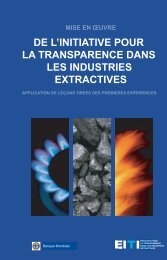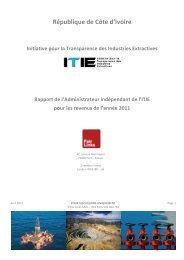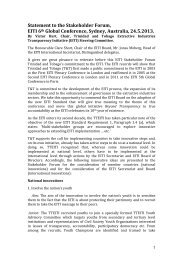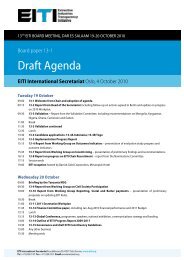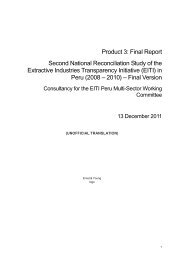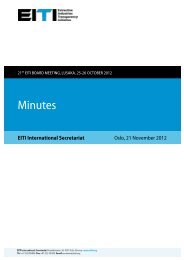Vietnam feasibility study - EITI
Vietnam feasibility study - EITI
Vietnam feasibility study - EITI
Create successful ePaper yourself
Turn your PDF publications into a flip-book with our unique Google optimized e-Paper software.
Although, the investment in the mining sector has created a number of jobs for society, compared with<br />
the number of jobs in other economic sectors, the number of employees working in the mining sector<br />
is also not commensurate with the investment (ranking at 11 of 18 from 2000 - 2008). Furthermore,<br />
of the mentioned number of employees working in the mining sector is actually, less than 50% are<br />
permanent. The remaining 50% is working as short term employees with unstable income.<br />
export and import<br />
The mineral commodities after processing are often in a raw form with a low quality and value. For<br />
example, <strong>Vietnam</strong> exports 100% of crude oil and 50% of coal each year. Hence, the export value of raw<br />
products is not sufficient for importing refined mineral commodities to serve the economy (Table 3).<br />
No Products<br />
table 3. Import and export of some mineral commodities in 2009<br />
Amount<br />
(mil tons)<br />
Export Import<br />
Value (mil USD)<br />
1 Coal 25.139 1.326<br />
2 Crude oil 13.416 6.210<br />
Amount<br />
(mil tons)<br />
The Extractive Industries Transparency Initiative and the Implementation Perspective of <strong>Vietnam</strong><br />
Value (mil USD)<br />
3 Petroleum 1.688 841 12.512 6.159<br />
4 Ore and other minerals 2.138 136<br />
5 Liquefied gas 753 420<br />
6 Other petroleum products 532<br />
7 Chemicals 1.598<br />
8 Steel 9.632 5.282<br />
9 Other metals 549 1.616<br />
Total 8.513,0 15.607<br />
I.3 - sTakeHOlDers anD THeIr rOle In THe eXTracTIve InDusTrY<br />
Source: 2010 statistics - Ministry of Industry and Trade<br />
The role of state agencies: (i) The Government is in charge of executive management and general<br />
operations for the activities in the EI sector; (ii) Ministry: the Ministry of Industry and Trade (MOIT), the<br />
Ministry of Natural Resources and Environment (MONRE), the Ministry of Planning and Investment<br />
(MPI), the Ministry of Finance (MOF), the Ministry of Construction (MOC), and ministerial level bodies<br />
manage revenues and mining activities at the nation level; (iii) The People’s Committees at all levels<br />
have responsibilities to manage mining activities and revenues in the local area. The roles and<br />
responsibilities of these authorities are summarized as follows:<br />
• Ministry of Natural Resources and Environment: In addition to the advisory responsibility to the<br />
government on natural resource management and environmental protection, MONRE also has<br />
responsibility to propose mechanisms and policies related to revenue generation from mineral<br />
extraction activities to the government and to other related ministries.<br />
• Ministry of Industry and Trade performs the state management function in relation to industry and<br />
trade. MOIT is responsible for mechanics, metallurgy, electricity, new energy, renewable energy,<br />
petroleum, chemicals, industrial explosives, mining industry and mineral processing, import and<br />
export, market management, trade promotion, e-commerce, service trade, economic integration,<br />
international trade, and competition management.<br />
• Ministry of Planning and Investment: functions as an advisory body for the government on strategy<br />
and development plans for the EI. MPI also has responsibilities in formulating development plans,<br />
mechanisms and policies for domestic and foreign investment.<br />
• Ministry of Finance is the agency that directly collects all taxes, fees and charges derived from the EI.<br />
19



